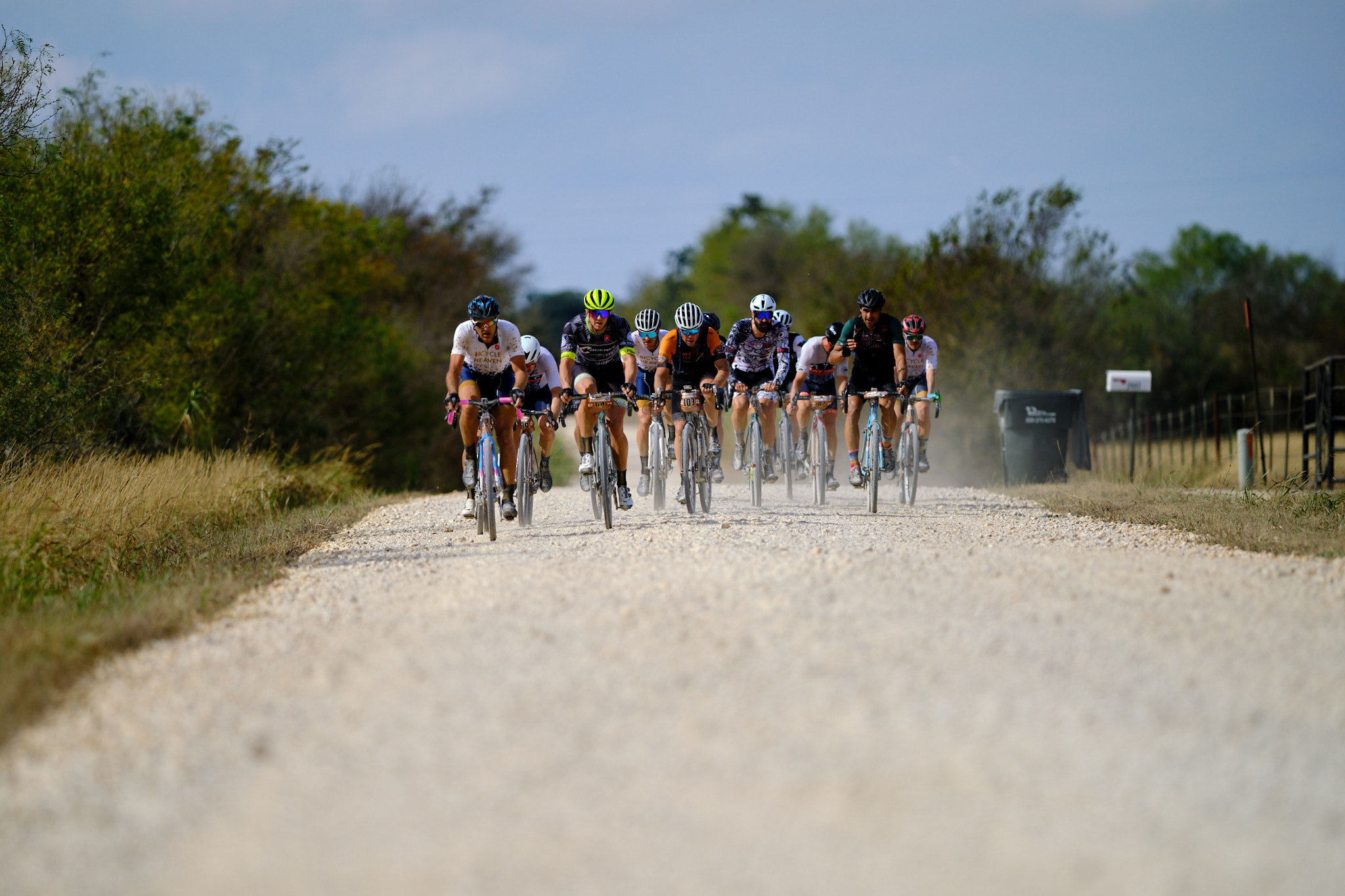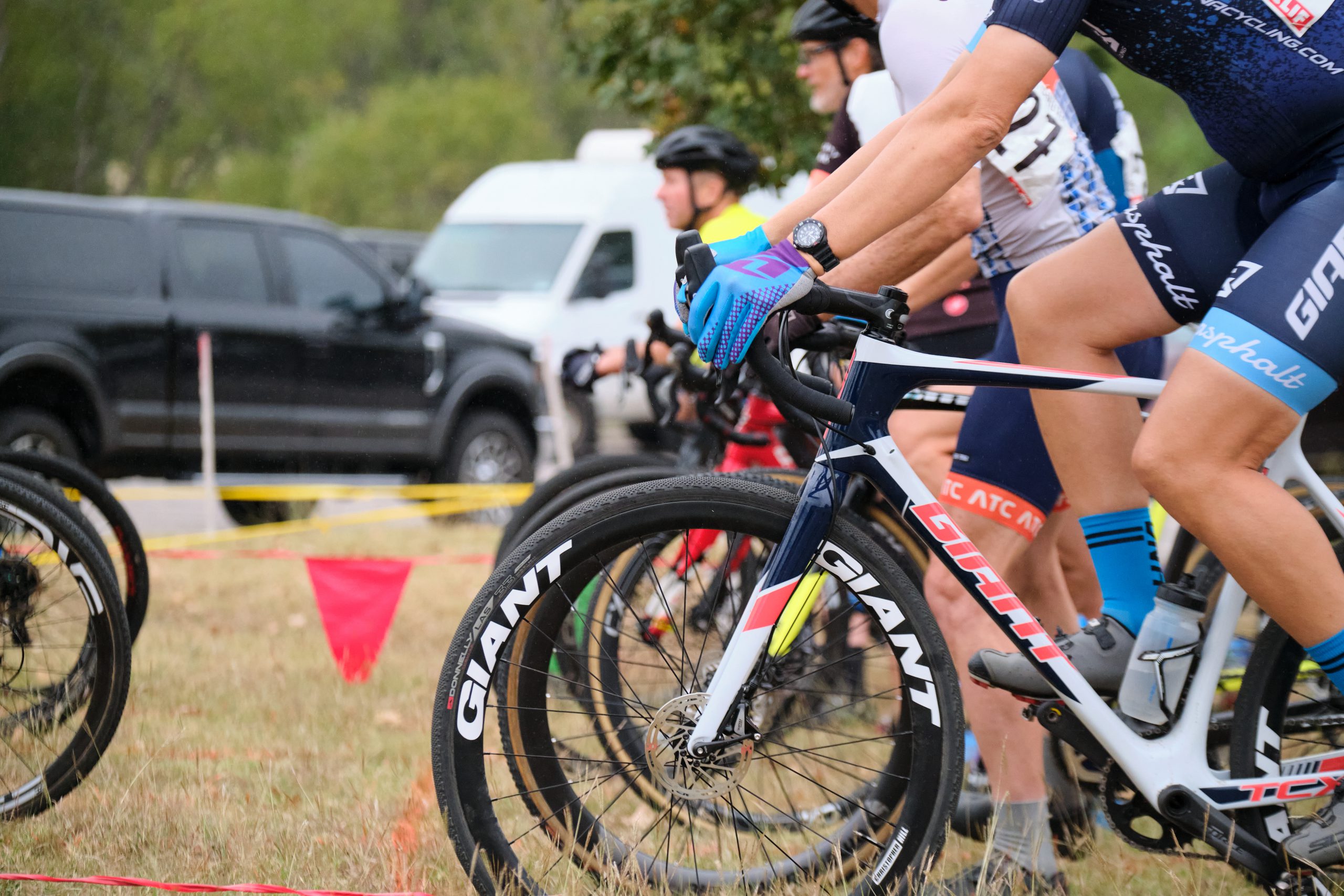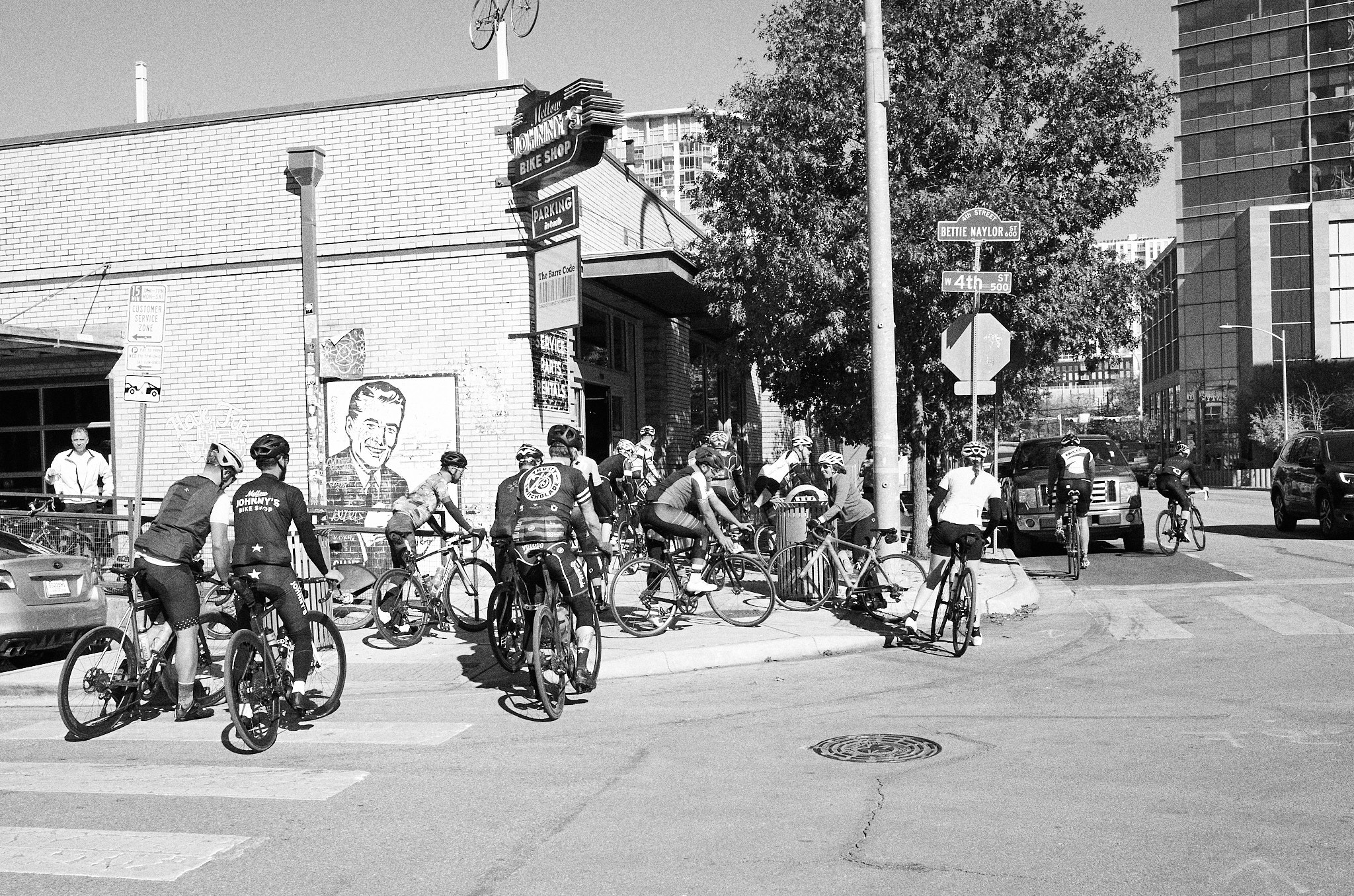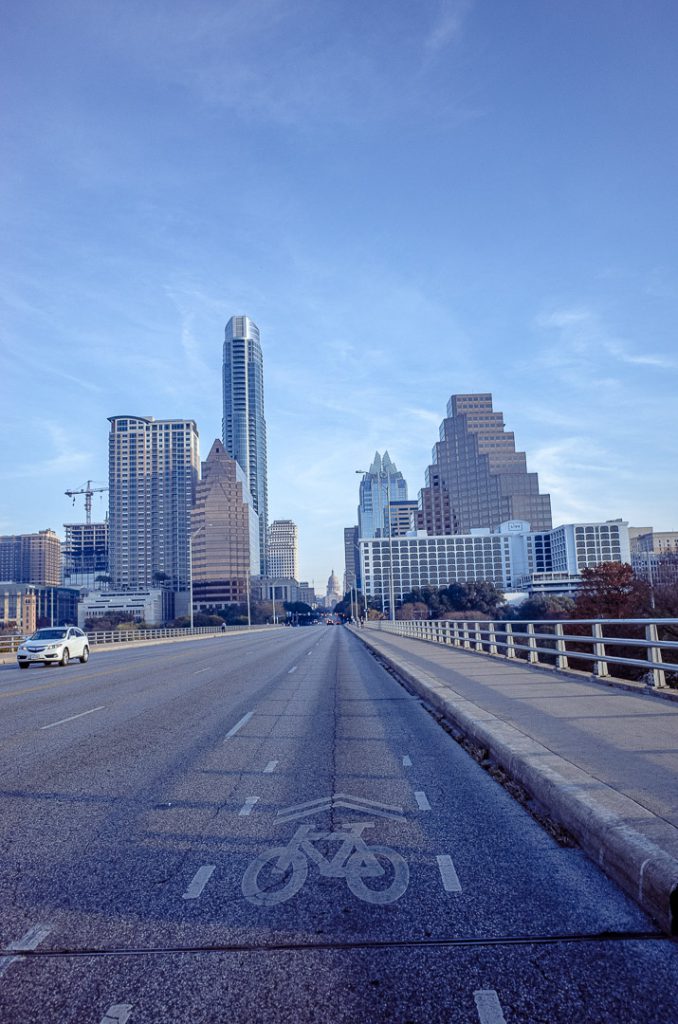Shooting Gravel Events
It would be presumptuous to claim much lived experience in the area of photographing gravel cycling races, yet each passing event provides a few lessons that improve my ability to arrive at the place I need to be at the time I’m supposed to be there. To organize my thoughts before an upcoming event, I thought I'd share the strategies I've established thus far.
An important characteristic of American gravel events from a photography standpoint is that, rather than traversing mountainous terrain with few throughways in the style of a European road race, the course typically forms a loop made up of gravel lanes bisected by numerous paved roads and state highways, so while it’s difficult to drive over the course much faster than the quickest riders themselves, especially when trying to pass them on narrow dirt roads, these highways serve as quick transportation between various photo spots along the way.
Assuming an average speed of 20mph for the front group, one can travel to three or four locations on a shorter course (with time to set up between) without covering riders in road dust.
Here are three representative courses. All are in different parts of the country, but follow the same basic pattern:
Bull Grind: A shorter event outside Austin, TX - https://ridewithgps.com/routes/33124238
Dirty Kanza 2018: One of the largest gravel races in the US (now called Unbound). Emporia, KS - https://ridewithgps.com/trips/23860354
Barry Roubaix 2018: A popular even in northern Michigan - https://ridewithgps.com/trips/22333636
Planning
For high-level professional work, I suppose a dedicated GPS with pre-programmed points would be ideal for navigating an event. In my case, I’m simply using a phone and Google Maps. Are you familiar with Google’s My Maps product?
My Maps allows you to upload and annotate course .gpx files and then navigate to points along that route. If a course has, say, 30, 60 and 90 mile events, each can be uploaded and simultaneously displayed to determine where the courses diverge. My hope is to take photos at three or more points: One that catches all three groups, two that the mid-distance group will cross, and one final point that will only see the main event, plus the finish. Even if the front group is missed at the finish, it’s easy to poach stragglers once you finally make it back to the starting point.
Planning on desktop:
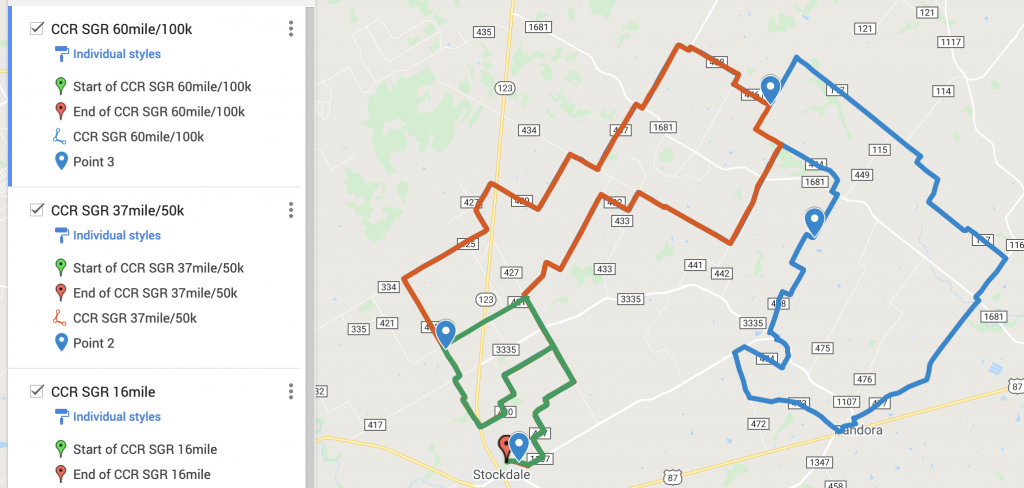
Unfortunately, My Maps doesn’t include Street View, which is an important part of selecting the most attractive spots if you won’t be pre-riding or driving the course. My solution is to keep the course open in RideWithGPS.com, where changing the map style from “RWGPS” to “Map” will enable the draggable Google Street View marker (though many of these remote roads won’t have Street View available). Alternatively, creating a point in My Maps and copy-pasting its coordinates to Google Maps also works.
I look for hills, curves, beautiful countryside and, of course, gravel. Riders want to be photographed looking like Colin Strickland and not Team Ineos.
Timing
Average speeds vary widely in an open gravel event. Unlike road races, where licensed riders are participating in their designated categories and traveling in a fairly compact group, gravel events are fondo-style, with both “racers” and “riders” in the same event. Remember those math puzzles from your SATs: “If two trains leave the station at…”. Who’d have thought you’d ever actually use that stuff? Well, it’s helpful here.
With a big speed gap, the first and last riders can already be 20 minutes apart only ten miles into the race and, when that final rider passes, the front group will already be 7 miles up the road, which could be almost half way to your next point — a 20 minute drive. Timing is important.
The first point along the course should be relatively close to the start if you hope to catch most of the field before moving on, perhaps ten miles in or less. If the race has a neutral roll out then you’re in luck, as this will slow things down a bit as you make your way out onto the course.
I use 20mph for the front group and around 12mph for the stragglers on the short route, and closer to 14-15mph for the mid-pack riders on the longer courses. This isn’t perfect and varies with terrain and gravel-chunkiness, of course, but uses time efficiently. The reality is that you can’t wait for everyone. I’ll figure out the spread between the front and rear of the field and write down estimated times, and then update them with actual times and speeds as the event progresses. Even made a spreadsheet for it:
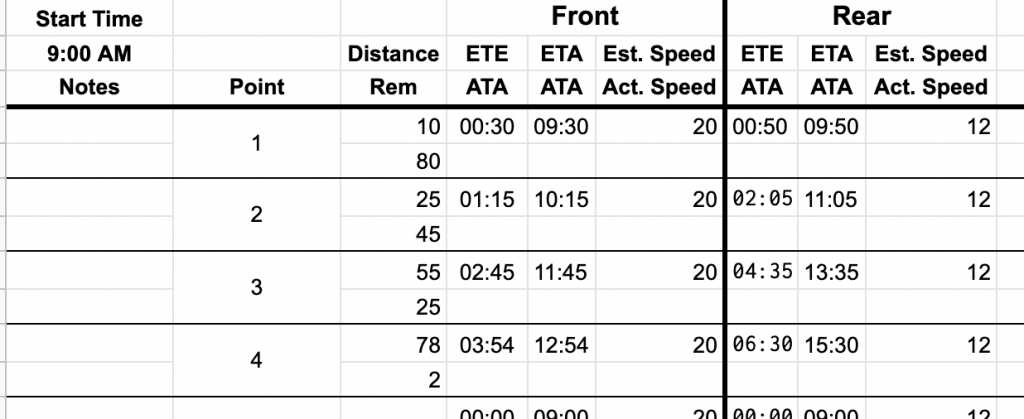
Realistically, the wait time will increase over the duration of the event unless you’ve got a compact course (or are a fast driver) and, eventually, the stragglers will be too far behind to wait. In the image above you can see that the last riders are crossing Point 3 well after the front group has reached Point 4. I have yet to devise a strategy for handling this over the massive distances of some gravel events, but maybe 2021 will present opportunities to experiment.
Positioning
I certainly haven’t mastered the art of positioning myself for the greatest variety of shots. The top World Tour photographers do an incredible job here, and the diversity of their photos is amazing (see Jered Gruber’s work). Of course, their role is more that of documentarian, while I’m trying to get varied shots of as many participants as possible, which can subsequently be purchased for #lightbro use on the ‘gram.
As previously mentioned, areas with hills, curves, beautiful countryside and gravel help create the money shot. The best spots present two completely different scenes in each direction. Even better if it’s also a place where riders double back after a loop. Curves are great because you can photograph the field in different settings with a short walk, or catch the added dynamism of riders taking curve.
These two photos were taken on opposite sides of a curve where riders were also doubling back:
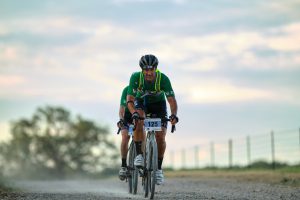
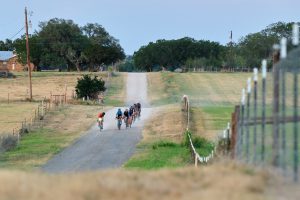
Getting into position can be a little anxiety-inducing, as once “they’re off!” so are you. And if you don’t know what you’re doing, then you’re going to fail at the job you came to do. Have an idea of where to park for a fast escape after the start of the race, and DO NOT try to drive the course. You won’t be able to pass the mass of riders (ask me how I know).
After taking photos at the start, I’ll rush to my car to navigate to the first point. With the timing and points already worked out, this is easy. I simply open My Maps, choose the first point and drive.
Unpaved roads often also mean poor cell service, so I download the map area onto my phone ahead of the event.
Equipment
Though my current setup may change, I’m happy with the results I’m getting using my Fuji X-T3 with the 50-140mm (~70-200mm equivalent) f2.8 lens along with the 200mm (~300mm equivalent) f2 prime, which I rent (because it’s $6,000!).
Fujifilm cameras aren’t necessarily designed for sports, however, for the price, they're an accessible tool for the job. The autofocus works well and with everything set up correctly my miss rate is relatively low. Some other features of this system are also great for sports:
- Pre-Shot AF - When pre-focusing on a subject, photos go into the buffer before the shutter is pressed. When the shot is taking, these “pre-shot” photos are saved to ensure you’ve captured the critical moment. Note: This only works using electronic shutter.
- 11fps with mechanical shutter. This is plenty fast for my purposes, as I’d rather not fill my card with thousands of throwaways. Still, with electronic shutter and a slight crop called “sports finder mode”, the camera can shoot up to 30fps.
- Cost. Sure, I’d love to have a Sony A9 or Canon 1DX for sports, but they’re expensive AF. Fuji offers a versatile system for a good price.
Settings:
Continuous autofocus (AF-C) is the tool designed for the job, and that’s what I’m usually using for action shots. Single (AF-S) can work well for slower moments or wider depths of field, and I appreciate the ability to recompose shots using AF-S. At f2 with a cyclist moving toward you, though, there’s no time to recompose as they’ll be out of focus almost instantly (see "Depth of field in front" with different numbers here). Different compositions can be achieved with AF-C by moving the focus point, but there’s no saying what framing will look best when the peloton comes through. For this reason, I usually just go for center-of-frame and crop later.
As to whether to use zone focus or not, it really depends on the situation. With bunches of riders, I prefer the single focus point for the ability to select individual riders in a bunch. Zone tends to jump around and sometimes feels like guesswork, and I much prefer the tighter control of selecting who’s in focus. On the other hand, zone works much better with individual riders as it’s more likely acquire focus and track the subject.
Another issue with zone focus is that if it locks to a rider's shoulder, wheel, handlebar, etc., the face will be soft at an extremely shallow DoF. The Fuji 200 f2 is beautiful, but can be tough to work with when shooting wide open.
What AF-C custom settings are best using zone focus? I have no idea. I’ve experimented with preset 1 and 3, and currently have a custom setting of Tracking - 2, Speed Tracking - 1 (both the middle settings). I don’t rely on tracking much and, perhaps foolishly, attempt to command the camera to focus where and when I want it.
The use of electronic shutter is sometimes cautioned for action shots, as movement can cause a rolling shutter effect. I have yet to notice this in my action photos, and some of my best shots were taken with electronic shutter. In fact, the Pre-shot ES setting actually requires it. This setting keeps images in the buffer and then saves them once you press the shutter, effectively giving you 20 more captures before the decisive moment. This is significantly more frames than I want to sift through, so I typically leave it off except for the most critical shots.
Back Button Focus is another technique with which I’m experimenting and I plan to use at the next event. The AE-L button is set up for "AF on" as it’s easier to reach than AE-F, and I’ll leave the focus switch in Manual for the added benefit focus peaking.
One other relevant setting that I haven’t yet settled on is the use of ISO Auto. In variable lighting or when things are happening too fast to think about shutter speeds, ISO Auto can save you from trying to shoot a moving subject at something like 1/100. Unfortunately, the fastest minimum speed you can set on a Fuji camera is 1/500. I’d love to see this bumped up to 1/1000 or even higher.
Capture One
Though digital asset management isn’t its strong suit, Capture One is my preferred photo editor, in part, because I use the Fuji system (google “Lightroom worms”). After becoming comfortable with it, I’ll probably stay with Capture One regardless of my future file types, as the ability to use layers without leaving the program is powerful, and you simply can’t unsee the beautiful RAW rendering.
After an event, I’ll download the photos directly to C1 rather than culling with something like Photo Mechanic. I apply auto-correction to the photos during download, as I often purposely underexpose for faster shutter speeds. While some of my street photography is edited, I’ll often simply add Fuji's Eterna Vivid 500T film simulation to the photos to brighten them up, and crop when necessary. An alternative might be to bump up the saturation a little in-camera or just shoot with Eterna, but I tend to enjoy starting from "zero" with RAWs to see what I ended up with.
Extras
Despite numerous “this event is unsupported” warnings, there are always a few riders who fail to heed the instruction. And, to be honest, I can understand it. After driving two hours to a highly anticipated event only to discover that I forgot my third bottle or a tire boot, I’d be just as tempted to take the course.
I’ve been asked for water and tubes on multiple occasions (and even a rag so a hero of a participant could wipe down the attachment point of his artificial leg before continuing on).
I bring a bunch of water bottles for “emergency use only”, my tool set and some tubes. Additionally, I make sure I know the course: “How far until…?”, “Left or right for the 60 milers?”, etc. are frequent requests.
Conclusion
Don't take these words as the recommendations of a seasoned pro. I'm preserving my thoughts here for future review as I work to improve in 2021 (please let there be more events!). If it weren't for camera equipment, I could probably afford a gravel bike and ride in these events instead of photographing them. Nevertheless, providing a service to the riders and being part of the race without all the pain (except editing) is an enjoyable alternative way to "do bikes" while indulging a second hobby.
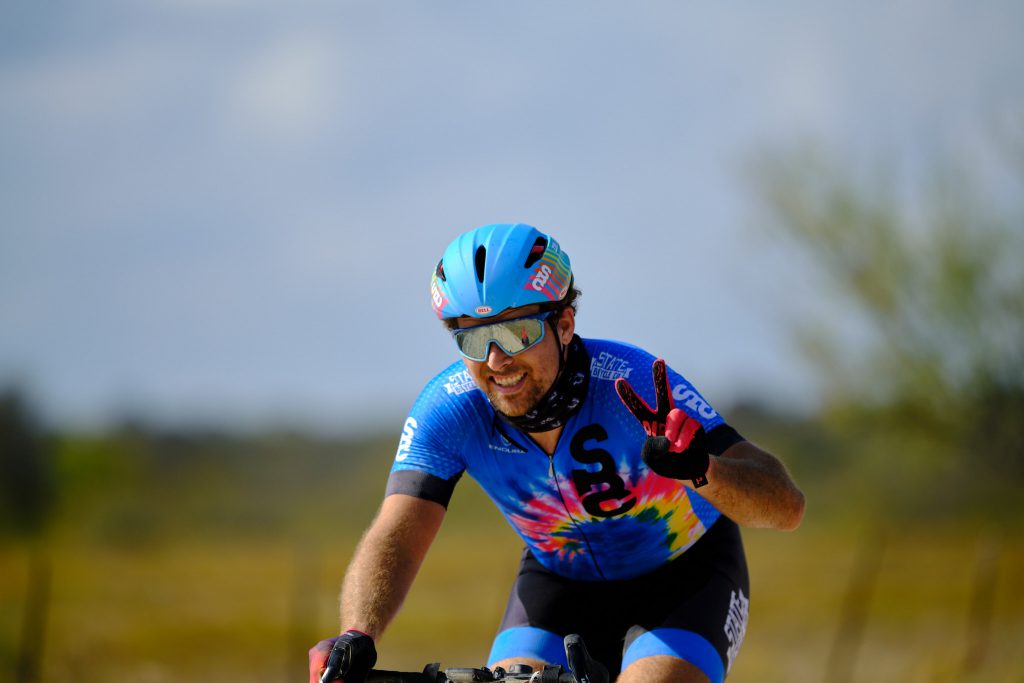
2021?
The great cancellation of 2020 put a huge damper on a year in which my goal was simply to “do bikes”. Now, with cooler weather and that niggling fall feeling of wanting to briefly put the bike down and look ahead, I’m left staring at a blank calendar speculating about 2021.
Certainly, there will be more events, right? The only two for which I’m confirmed are Unbound (Kanza) and The Garden State Fondo, with this year’s registrations deferred to next (add Castell Grind to that list as of a few days ago). Will the local crits and road races take place? Is the early-January gravel grinder still on? At this point, there’s no way to know, especially considering the haste with which many smaller races seem to be announced.
As much as I want to copy-paste my TrainingPeaks for a do-over of all that was missed in 2020, proceeding as though this all never happened, it simply isn’t possible. The idea of “eventually back to business as usual” that we all accepted as truth seems to be wearing thin. Some areas are reinstating new lockdowns and, from a personal standpoint, my employment situation could be pretty shaky by next summer.
Careening toward unemployment while participating in an expensive and possibly injurious sport feels irresponsible, especially with so many other interests, such as running, which I left behind for cycling.
At the same time, if events do return in full force, participation in each will be made all the sweeter by its prior loss in 2020.
It’s a Catch-22. Plan or don’t. Optimism or crushing reality…
Wait...
...no it isn’t. This is a false dichotomy caused by the internet and too much time alone. A depressive mope from looking backward rather than forward. A child who gives up after someone beat him to the first piece of candy that fell from the piñata.
Sure, things can seem pretty bleak when contemplating the dreariness of it all whilst doom scrolling through one’s newsfeed, but the thing I’ve noticed about bikes is that, after kitting up and dragging yourself outside, the weight of all that negativity falls away like…well, it just falls away. I think this is because bikes are a great way to launch oneself out of rumination and into reality. They’re a reminder that life is more your actions than thoughts, that doing something is more powerful than giving in to doing nothing, that things are gon’ be alright.
So, 2021…worth planning for? Absolutely. I just bought my Unbound bike, and if it doesn’t happen, so what? Things may not be perfect, it may be necessary to trade Rapha and carbon for cotton tees and steel, but that’s 1000x better than sitting home and waiting for perfection. Even if 2021’s calendar falls far short 2019, there will still be unofficial events, epic solo rides, unsanctioned races and group rides to enjoy. It's going to be fuarking awesome, because bikes.
Welcome to Austin, New Cyclist
Before COVID, Austin was an outstanding place to be. Wonderful bars and restaurants, great ways to experience nature, and a plethora of events every day of the week - all taking place in year-round nice weather (though sometimes a bit hot).
One more feather in Austin’s cap, and a big reason I continue to live here, is the city’s great cycling community. Austin is full of commuters, road cyclists, casual trail jaunt-ers anything in between (including some pretty awesome pedicab services). As with everything else, most cycling-related events have been cancelled this year, however, one thing that isn’t cancelled is enjoying the outdoors, which many have chosen to do by bike over the past several months. Nay, Covid has caused a bit of a national bike boom, with demand so high that many shops are repeatedly selling out of new stock, and maintenance services are backed up for weeks.
With so many new cyclists on the road, it’s a shame we can’t welcome them in the usual fashion. Someday, though, normalcy will return and, with it, all the things that make riding bikes in Austin great. You, new cyclist, should be ready when that day comes, so here’s an over of some of the more prominent contributors to the Austin cycling community.
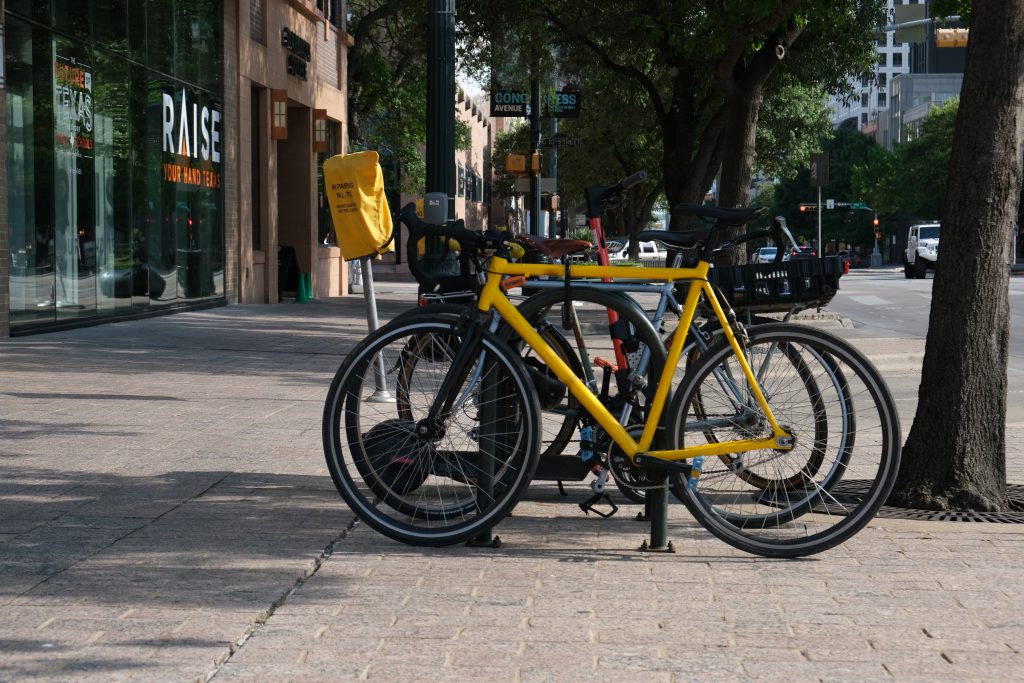
Organizations
Social Cycling Austin
Start here. Seriously. Social Cycling Austin is a FB group of over 12,000 members representing every possible cycling niche. The group is an amazing place to ask questions, find people to ride with, learn about Austin cycling, in general, and is also the home of the famous Thursday Night Social Ride, which has become an institution in the community. Think of SSA as your all-purpose, one-stop-shop for general cycling info in Austin.
https://www.facebook.com/groups/socialcyclingaustin
Bike Austin
It’s good to be a member of Bike Austin. This is an advocacy group that works closely with city government on bicycle issues - most importantly, safety. Bike Austin hosts rides, garners support for city projects and gives back to cyclists in the community. During COVID, the organization helped build support for Healthy Streets to allow pedestrians and cyclists to enjoy socially-distanced recreation without having to worry about automobile traffic. The more cyclists we can get behind Bike Austin the better.
Ghisallo Cycling Initiative
Ghisallo provides bike-related educational programs to Austin’s youth with the aim of creating lifelong cyclists, and also normalizing the use of bikes for transportation. The group conducts clinics focused on safe riding as well as numerous bicycle maintenance programs. If you’re a parent who wants to bring some cycling education to your child’s school, Ghisallo is a great place to start.
Violet Crown
Violet Crown is the oldest and largest cycling club in Austin, and they have the old newsletters and photos to prove it.If want to hear stories about Lance and the old Tuesday Nighter, Violet Crown is your jam. This organization facilitates numerous weekly group rides, and you’ll likely see riders sporting VC kit at other group rides as well. If you’re getting more serious about cycling and want to ride with faster groups or are considering racing, Violet Crown is a great place to get started.
Yellow Bike Project
Ya know all those micro-mobility scooters and bikes you see sitting all over the city? Well, Austin’s Yellow Bike Project was an early adopter in this area. In 1997, they repaired hundreds of bikes, painted them yellow and put them on the street for Austinites to use for their daily transportation needs, for free! Unfortunately, human nature got in the way and the project eventually fizzled out. Still, the organization remains and is an outstanding resource for purchasing reasonably priced bikes in Austin, as well as learning to repair your own bike. YBP is a community bike shop, offering classes, open community shops and even an earn-a-bike program, in which you can earn a free bike in exchange for volunteer hours. I highly recommend you visit the shop to see what it’s all about.
Coffee Outside ATX
#CoffeeOutside is a national community of cyclists who meet up for, well, coffee outside, and #CoffeeOutsideATX is Austin’s iteration of the group. Multiple different meeting places are used that showcase the city’s many outstanding parks. This is a small gathering, but a fun thing to do and good way to meet people if you’re new to Austin.
https://www.instagram.com/explore/tags/coffeeoutsideatx/
Bike Shops
Austin is chock full of bike shops. You’ll have no problem finding the one that fits your vibe. And though I hate to exclude any, as I’m thankful for all bike shops (even the bad ones), I’ll briefly include here those with which I have direct experience:
Mellow Johnny’s
Mentioned first because it’s the most famous shop in Austin. Mellow Johnny’s, so named because it sounds like the french maillot jaunt (yellow jersey), is owned by Lance Armstrong and is full of classic Tour de France bikes and other memorabilia. The cycling artifacts, in addition to it being a great shop, make photo-taking out-of-town visitors a common sight in the store. Is MJ’s a great shop for the casual cyclist? Sure, they’re friendly and have some nice hybrid/commuter bikes. Still, I perceive MJ’s to be more geared toward the serious racing cyclist. They carry a lot of high end stuff and prices can be shocking, especially if you’re simply interested in cruising the hike ’n bike trail.
https://austin.mellowjohnnys.com/
Cycleast
To me, Cycleast is the “hipster” shop. They have an amazing coffee shop on location and many of the bikes you see being sold or parked outside are of the steel (and sometimes single-speed) variety. But don’t be fooled, this shop hosts some amazing competitive riders and is also the home of Austin’s Phenom Cycle Club - a popular group in the racing community that holds the weekly Phenom 50 ride. I prefer to have my commuter serviced at Cycleast because they’re down-to-earth and reasonably priced (and within biking distance of my home).
Bicycle Sport Shop
I spend significantly more time at Mellow Johnny’s due to their co-located coffee shop, however, Bicycle Sport Shop is still my favorite shop in Austin, namely the South Lamar location. They’re huge and nationally known, with five locations in Austin, yet still manage to to feel welcoming and familiar. The owner, Hill Abel, is also an outspoken cycling advocate, which I appreciate. BSS caters to everyone, and is both an outstanding place to buy your first “real” bike, or your 10th high-end carbon race bike. Of all the shops in Austin, I’d say Bicycle Sport Shop appeals to the widest clientele.
Bike Farm
Let us not forget Bike Farm, a small shop slightly further away from my usual bubble of existence, but worth the trip nonetheless. Bike Farm carries brands that the other shops don’t, many of which are more reasonably priced. They also have a huge used a new-old-stock selection, which can be browsed online from the safety of your standing treadmill desk. Literature aficionados will also appreciate the titles on their service menu.
Other Events and Resources
CapMetro
Did you know that you can bring your bike on the bus? It’s true! Capital MetroRail also invites riders to bring their bikes. If you’re a commuter who lives a little further away and wants to use their bike for “last mile” purposes, CapMetro is a great way to do it. More transit centers are popping up around Austin and I can tell you from experience that it’s entirely possible to get around multi modally without driving.
https://www.capmetro.org/bikerack
Driveway Series
Even serious roadies who don't live in Austin know about The Driveway Series. It's arguably the best weekly criterium series in the country, and also a just a fun place to be. On Thursday evenings, you might see speed suit adorned riders making their way to the east side of town for the weekly race or returning at twilight for tacos and beer a La Mancha Tex Mex Tavern. Driveway is a culture and, in my opinion, one of the coolest thing about Austin. Here's an intense promo video from their site:
CotA Bike Night (is awesome)
Circuit of the Americas in an Austin landmark, and the only purpose built Formula One track in the United States. Its scale is hard to appreciate from afar, so why not see it up close? CotA Bike Night, held every Tuesday throughout the summer is fun way to ride without having to worry about traffic in a truly interesting environment. All kinds of riders are welcome. You’ll see teams doing workouts, families with kids, e-bikes and everything in between. Worried about climbing the 11% grade before turn 1? No problem. There’s a bypass to skip that portion of the track, but I recommend you take on the challenge at least once. Check out the view:
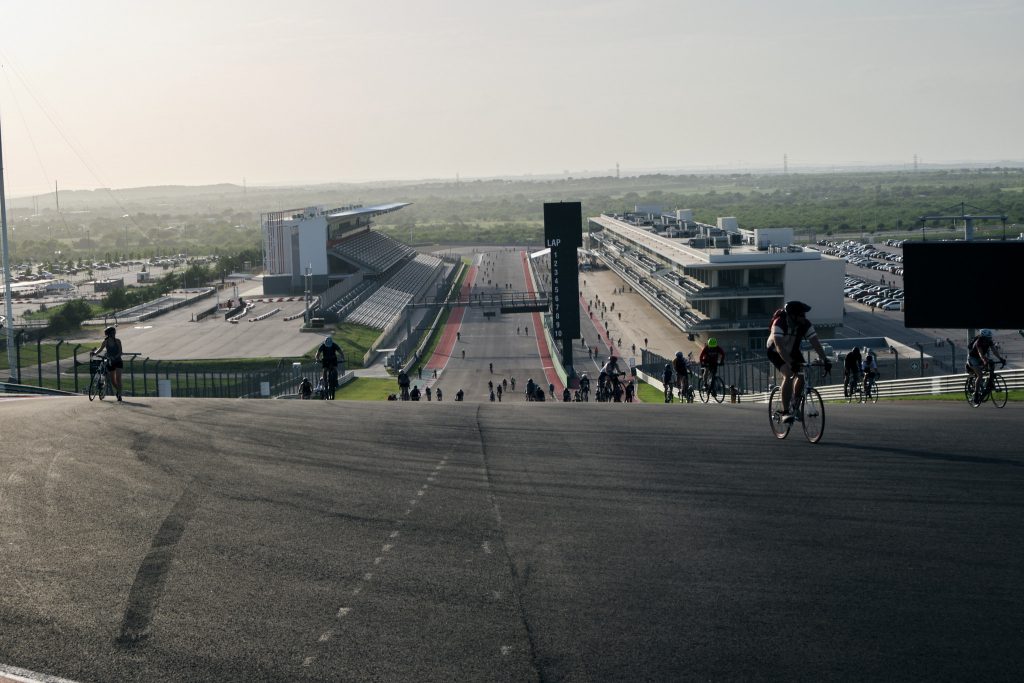
http://circuitoftheamericas.com/bike
The Veloway
The Veloway at Circle C Ranch Metropolitan Park was constructed in the early 90’s and was the first facility of its kind in the United States. The Veloway is a 23’ wide, 3.1 miles (5K) long bicycle tract that traverses the natural terrain. People travel from all over the metropolitan region to cycle here on a daily basis. The project was partially funded by a Texas Parks and Wildlife Grant. (I copy-pasted this)
https://austintexas.gov/department/veloway
Austin Bicycle Map
You’ll likely see this near the checkout in local shops, but it’s also available online.
Here’s the PDF - https://austintexas.gov/sites/default/files/files/COA_bike_map_v12_FULL_web.pdf.
And an interactive version - https://www.arcgis.com/apps/webappviewer/index.html?id=5d0284294f1b41bcad4ea956274a83b3&extent=3084002.7769,10048871.3815,3148002.7769,10081338.0481,102739
The map is well done, and I’ll say that I concur with most of the routes and comfort levels described.
Is Austin a bicycling Mecca? No. Riding here has its problems. There’s the ever-growing sprawl, crazy driving and a striking carelessness about transportation safety. Still, the city has a critical mass of riders that has normalized the sight of cyclists on the road and, as traffic gets worse, many of those who are able are choosing to get around by bike. The site of e-bikes during the morning and evening rush is getting quite common.
What makes riding in Austin great are the people. Take advantage of or get involved in the resources I’ve mentioned here and you’ll quickly find your niche.
